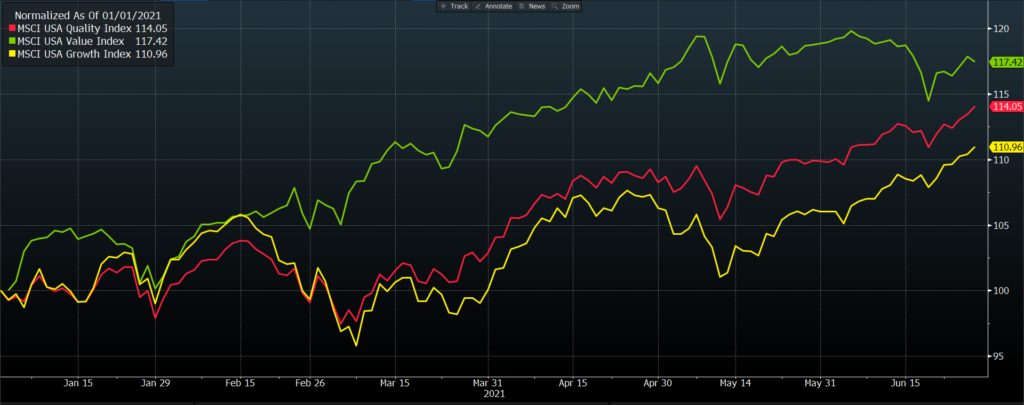In our sixth piece within our Risk Off Series, today we will explore how to manage equity exposures in a risk adverse market, through looking at the factors of value and quality.
To date, we have written about:
- Introduction to tail-risk and convexity
- Long/Short equity funds
- Alternative ETF’s
- Foreign currency exposure
- Interest rate duration
The topics we have covered have largely focused on ways in which investors can benefit from risk off sentiment – specifically in securities with relatively inverse relationships to market sentiment.
These trades may be suitable in short-medium term time frames, however they carry greater complexity than traditional risk off portfolio positioning, and may be unattainable within certain investment mandates.
Those investors who are unable to execute these trades, or are less confident in their ability to time markets, have the option to rotate/invest into value and quality orientated stocks.
In today’s note, we will examine the relationship between value and quality stocks and risk sentiment, the benefits this can provide to portfolios, and the ways in which you can gain exposure.
Value and Quality
Value and quality stocks are often regarded as similar factors, however before we dive into their relationship with risk sentiment, its important to define how we categorise these factors.
Value stocks are determined on the basis of financial ratios, like price to book (P/B) and price to earnings (P/E), with a focus on defining valuation in relation to their intrinsic value.
On the other hand, quality stocks focus on three concepts – profitability generation, earnings quality and financial strength (S&P Global: Ung, Luk, Kang [2014]).
Further details can be found in our factor series, where we explored value and quality stocks in greater detail.
Factor Rotation According to Risk Sentiment
During periods of market uncertainty, stocks with greater financial strength and favourable valuation metrics will outperform, given the enhanced focus placed on near term earnings.
Growth stocks, which carry greater weight on forecasted future earnings, often in markets which are not yet well established, carry less certainty for investors, and as a result, are less attractive when future economic outlooks become more negative.
As a result, those stocks with stronger and higher quality earnings will exhibit less volatility, and whilst they still may experience drawdowns, they offer potential upside should economies perform better than market expectations.
This is where adopting a rotation in value and quality factors offers advantages over strategies such as getting long interest rate duration, or alternative ETF’s, where you are still exposed to the upside should market quickly return to a risk on environment.
This has been made evident this year, with those investors opting to allocate funds towards value and quality factors being rewarded, given the risk off environment which has pervaded markets over the past few months.

Source: Bloomberg
Whilst one could attribute this performance to market wide factor rotation from growth to value driven by reasons beyond risk sentiment, the outperformance of the quality factor highlights how important of a role factors play during times of risk off market sentiment.
Get Defensive
By considering the underlying factors attached to stocks, investors can create portfolios which are more robust during times of negative risk sentiment.
Whether or not this allocation forms the majority, or a smaller portion of one’s equity portfolio would be determined by the individual risk profile.
However, regardless of how extreme one’s risk profile may be, an element of diversification is always key in ensuring maximisation of risk adjusted returns.
Building a portfolio compromised completely of growth stocks will most likely result in sub-par investment outcomes over the long term, given the benefits one can achieve through rotating their portfolio throughout the business cycle.
Exposures to these factors can come through multiple vehicles, however factor focused ETF’s offer the best possible option for those investors wishing to diversify away the idiosyncratic risk associated with holding individual companies.
ASX listed vehicles for value ETF’s are largely limited to the Van Eck Vectors MSCI International Value ETF (ASX: VLUE), which tracks the MSCI World ex Australia Value 250 index.
For quality, the VanEck Vectors MSCI World ex-Aus Quality ETF (ASX: QUAL) and BetaShares Global Quality Leaders ETF (ASX: QLTY) offer diversified exposures to those companies which satisfy the aforementioned quality criteria.
Safety in the Incumbents
The question which should define the investment decision process in times of economic uncertainty is – “am I willing to experience the volatility associated with my current exposures, in the event of a 20% market drawdown?”
For most, rotating portfolio positioning towards value and quality factors, will enable a maximisation of risk adjusted returns, as well as creating more robust and stable portfolios.
Consideration of the interrelationships between your existing equity holdings is important – your exposures may be diversified at an industry level however suboptimal portfolio outcomes can still occur should they be centralised within the same investment factor.
The views expressed in this article are the views of the stated author as at the date published and are subject to change based on markets and other conditions. Past performance is not a reliable indicator of future performance. Mason Stevens is only providing general advice in providing this information. You should consider this information, along with all your other investments and strategies when assessing the appropriateness of the information to your individual circumstances. Mason Stevens and its associates and their respective directors and other staff each declare that they may hold interests in securities and/or earn fees or other benefits from transactions arising as a result of information contained in this article.



